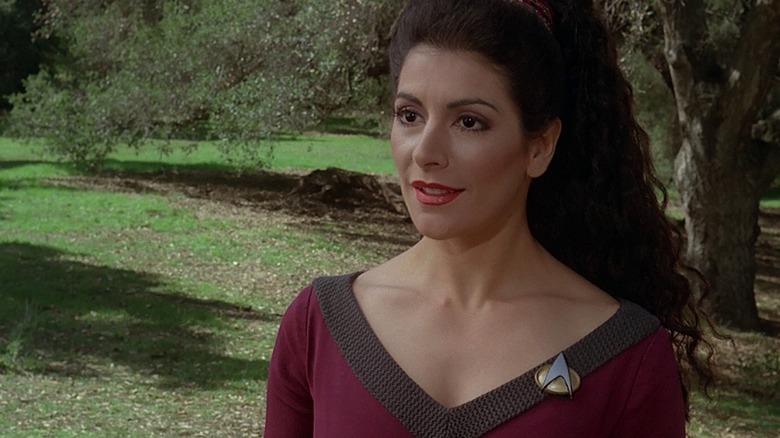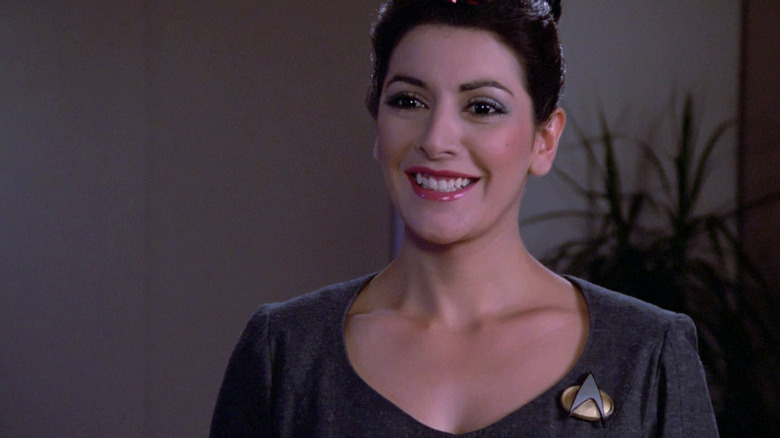A Discarded Idea For Star Trek's Troi Probably Would Have Stirred Some Controversy
When "Star Trek" first aired in the late 1960s, it wasn't an overwhelmingly popular hit. When the show was canceled in 1969, it was put into eternal syndication, and it wouldn't be until the mid-1970s that Trekkies would begin to appear in earnest. "Star Trek" conventions started to pop up in hotel ballrooms across the nation, and "Trek" creator Gene Roddenberry would occasionally appear at said conventions to discuss his creation with his many fans.
It was during these conversations, really, that Roddenberry began to mentally highlight the messages he put into "Star Trek." Fans, he saw, were responding to Trek's depiction of a world without war and money, a world where diplomacy and exploration took precedence over conquest and acquisition. Many loved the show's diversity.
When it came time to create "Star Trek: The Next Generation" in 1986, it appeared Roddenberry was eager to shift Trek's themes into overdrive. "Next Generation" was going to have even less conflict, even more diplomacy, even more gentle consideration of humanity's emotions. Indeed, some of the show's writers were frustrated at Roddenberry's infamous mandate that "Next Generation" feature no interpersonal conflict. In the future, Roddenberry said, people will get along.
No character symbolized Roddenberry's peacenik tendencies better than Counselor Deanna Troi (Marina Sirtis). Troi was half Betazoid, which meant she could psychically read the emotions of others. She was ready for missions of diplomacy, but also regularly talked to the crew about how they were coping. She also had a chair on the bridge, seated right next to the captain. Mental health was key.
She also originally had three breasts. Back in 2007, talking to EW, writer D.C. Fontana recalled the early days of "NextGen," and how she had to adamantly reject the idea that Troi be tri-breasted.
The three-breasted Counselor Troi
It shouldn't be forgotten that Gene Roddenberry, in addition to envisioning a future without war and conflict, was also an insufferable horndog. He clearly believed in free love, and exalted the importance of sex and orgasms on more than one occasion. He likely had no issues in the 1960s with keeping the show's female cast members in miniskirts.
Fontana recalls the early brainstorming sessions for "Star Trek: The Next Generation," and some of the ideas that would eventually make it onto the show. For one, the U.S.S. Enterprise was a much larger ship. The captain wouldn't be an adventurer but would remain on the bridge during away missions. Fontana also recalled the multi-breasted Troi idea:
"I objected to Troi having three breasts. I felt women have enough trouble with two. And how are you going to line them up? Vertically, horizontally, or what? I was like, 'Please, don't go there.' And they didn't, fortunately."
Adding an additional breast to a very human actress would have not only required a heck of a lot of makeup, but would certainly have pushed the boundaries of good taste. Three boobs sounds like a conceit from "Flesh Gordon" rather than "Star Trek." Fontana didn't say if it was Roddenberry who suggested Troi have three breasts, but Trekkies may infer all they like (although, honestly, it could have been anyone).
Incidentally, there is a character on "Star Trek" that had polymastia. An unnamed cat-like alien in "Star Trek V: The Final Frontier" — one who gave table dances at a dive bar on Nimbus III — had three breasts.
Also, actress Lycia Naff, who played Sonya Gomez on "NextGen" would also play a three-breasted sex worker in Paul Verhoeven's 1991 film "Total Recall."

